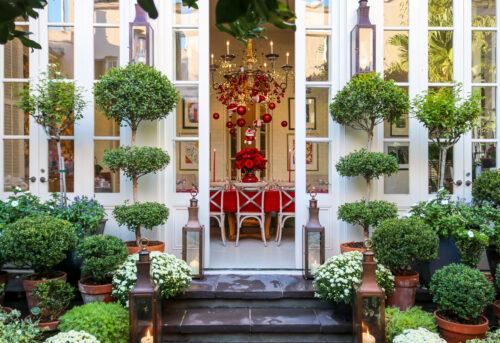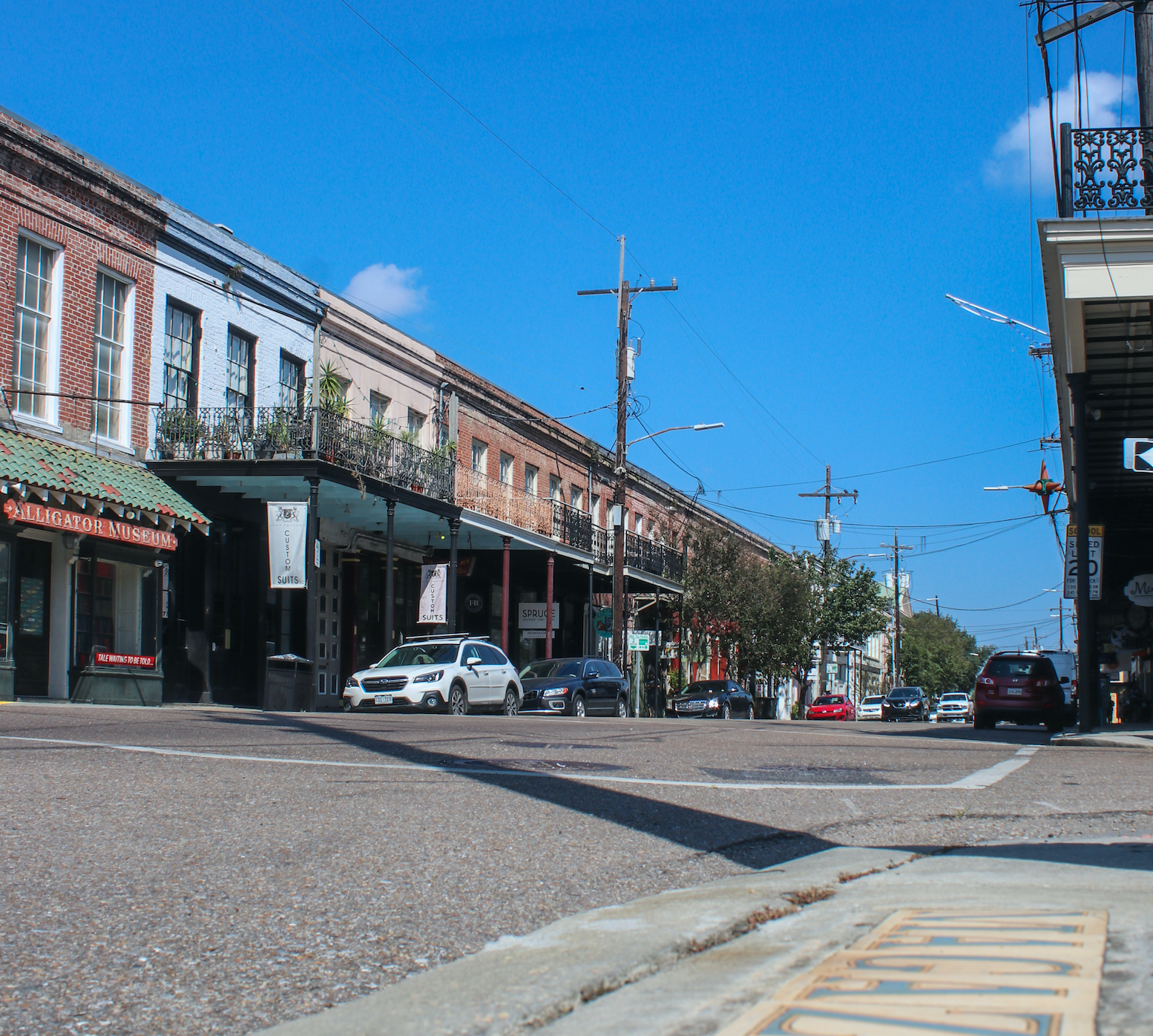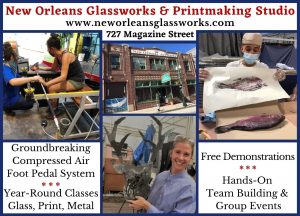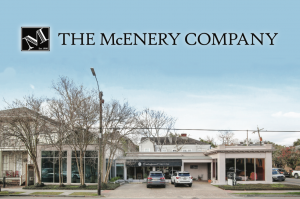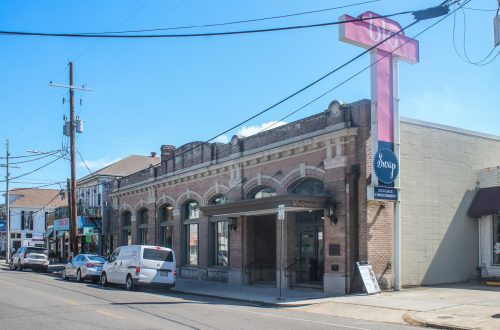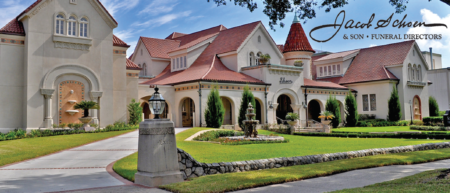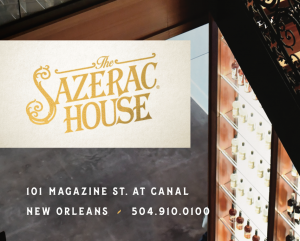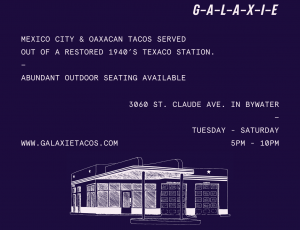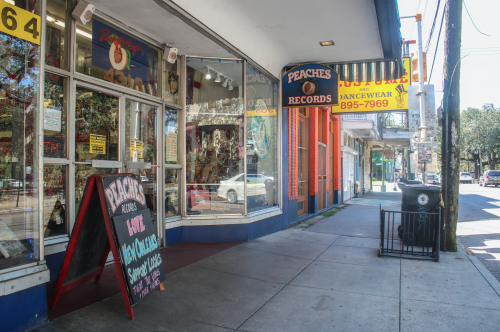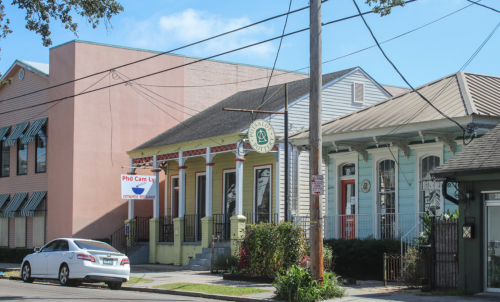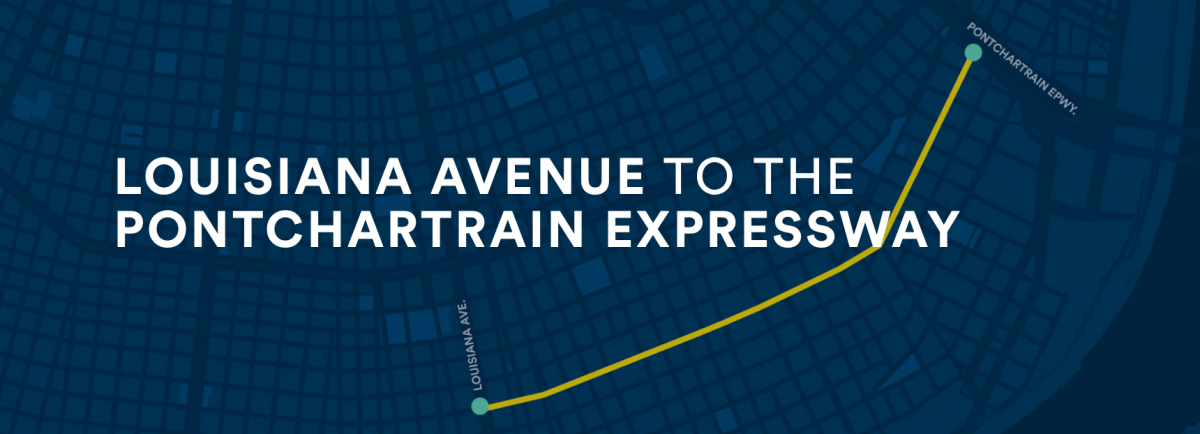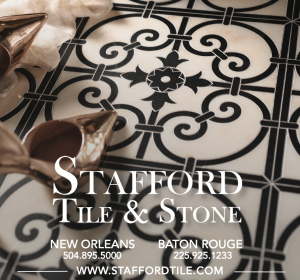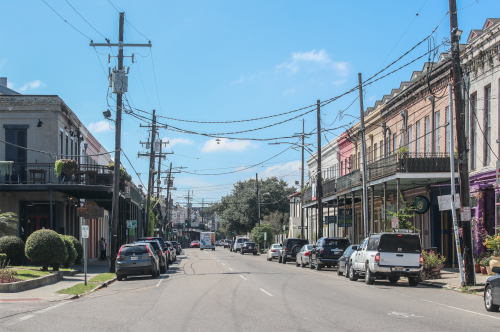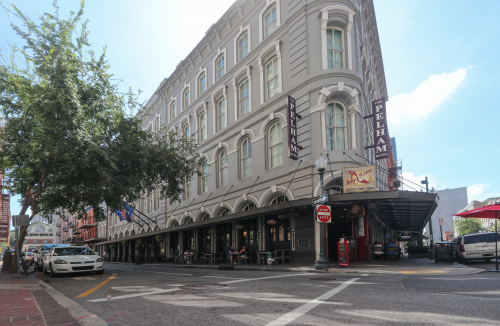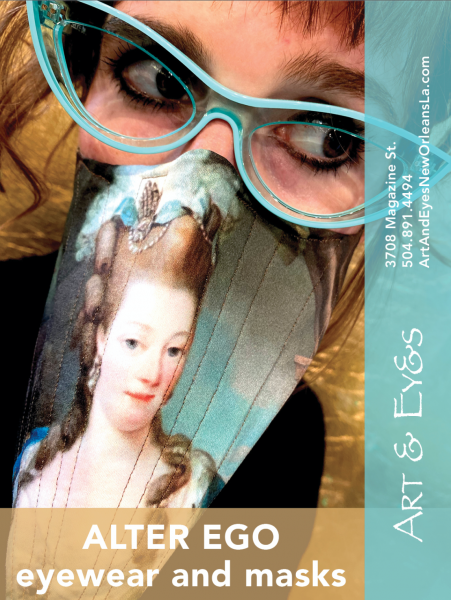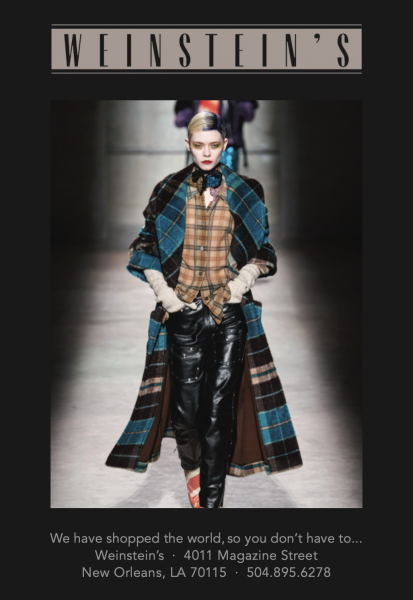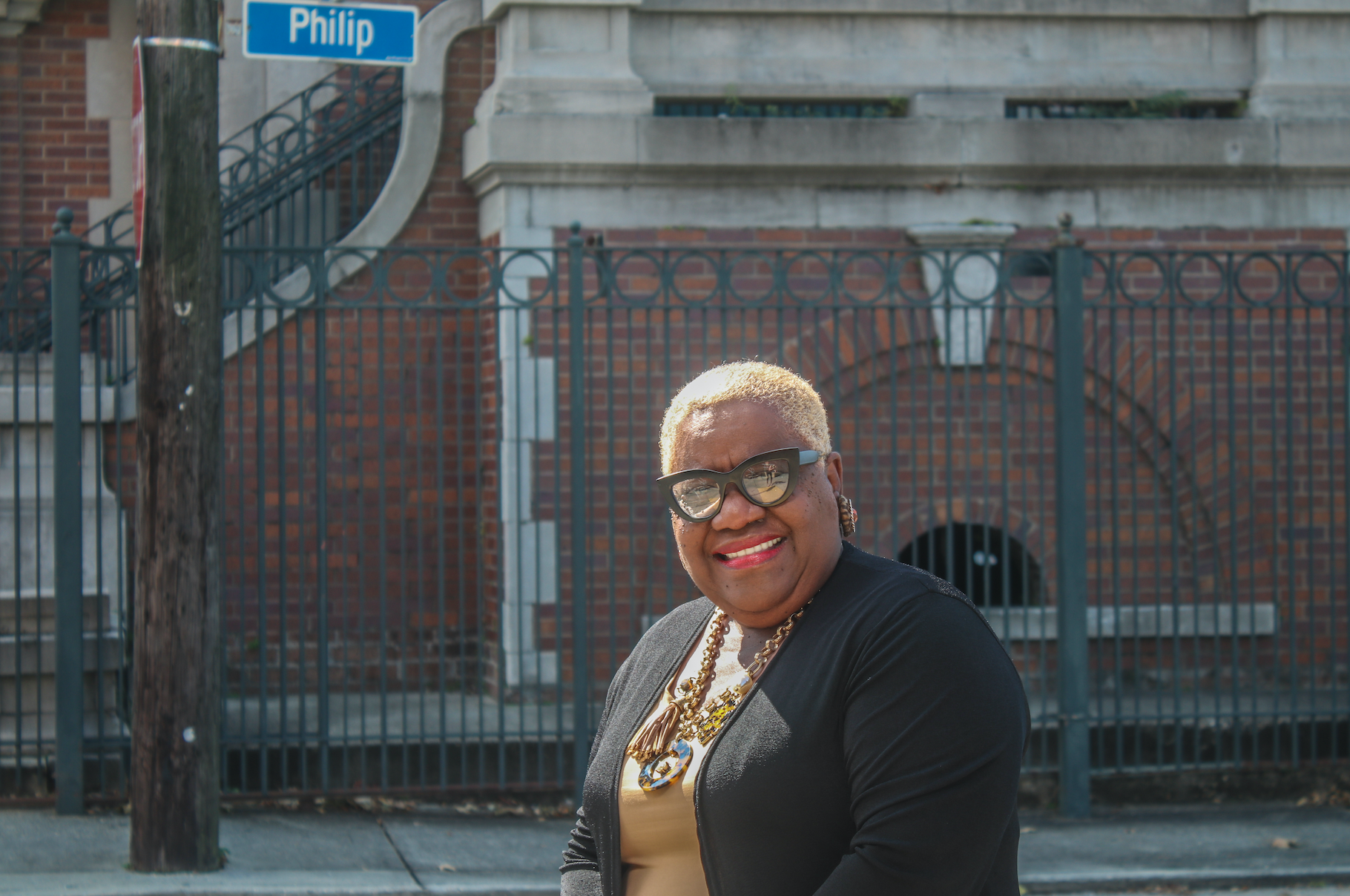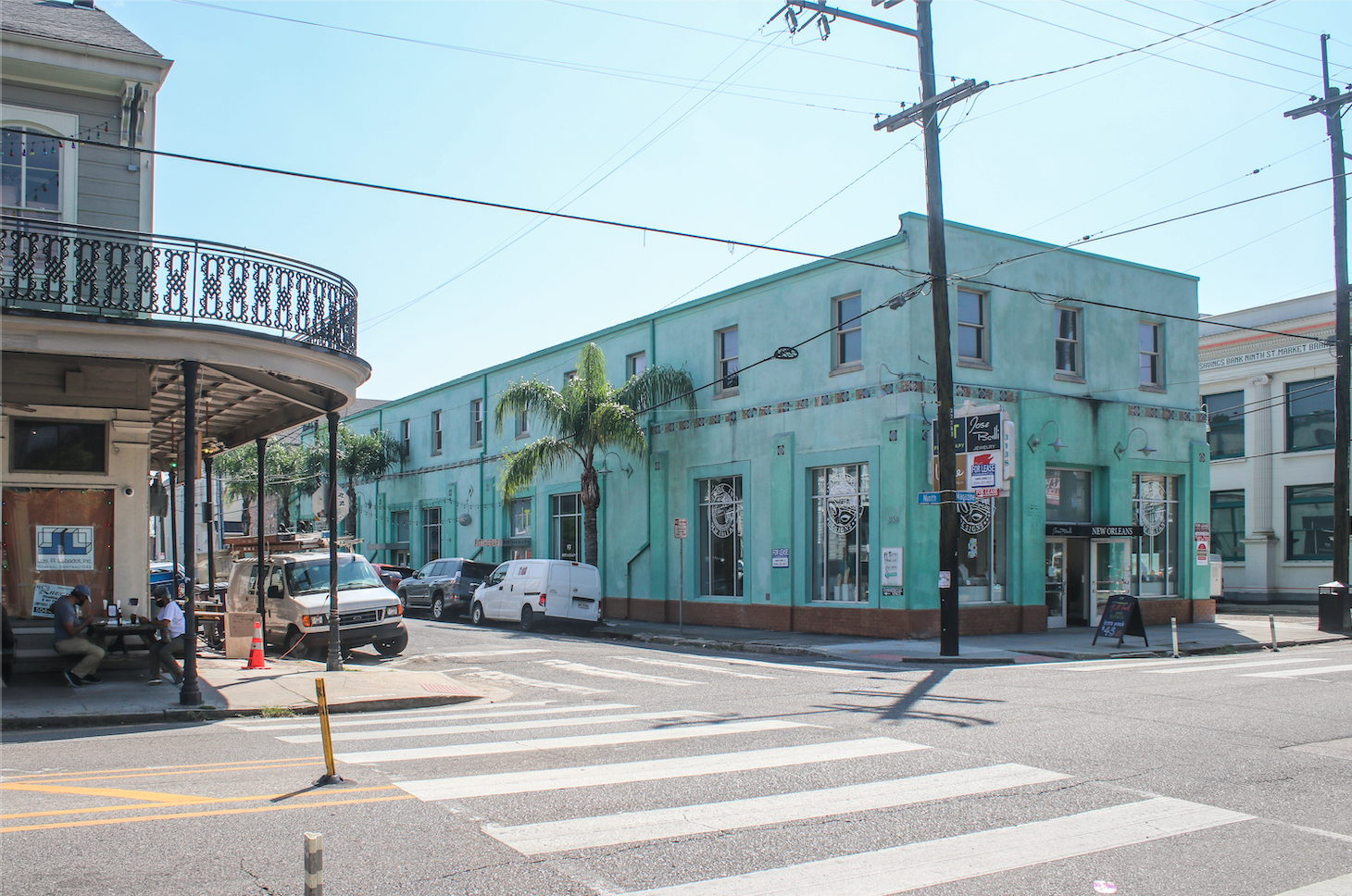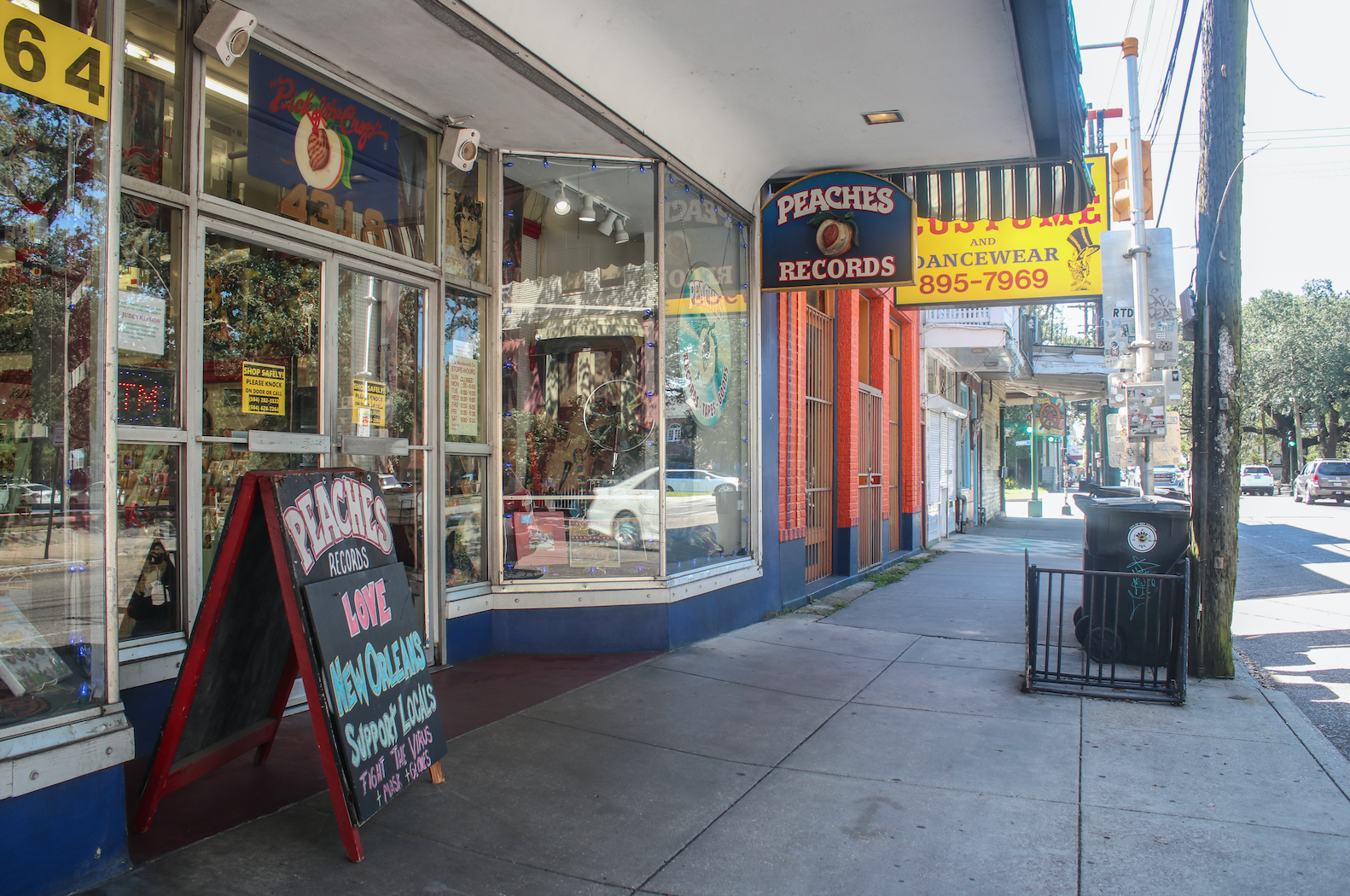This story appeared in the November issue of PRC’s Preservation in Print magazine. Interested in getting more preservation stories like this delivered to your door nine times a year? Become a member of the PRC for a subscription!
By Susan Langenhennig, Danielle Del Sol, Nathan Lott and Davis Allen. Photos by Liz Jurey
In the warm autumn weather of mid-October, signs were sprouting along the stretch of Magazine Street between Nashville and Jefferson avenues. Four for-lease signs hung in darkened storefront windows, a rare sight in one of the most sought-after retail destinations in the city.
“Temporarily closed,” read another sign, this one on the doors of the CC’s coffeeshop on the corner of Jefferson and Magazine. It had been posted there since spring.
“80 percent off” shouted yet another placard hanging in the window of British Antiques.
But not all of the signs on these blocks signified bad news. Near the corner of Joseph Street, Azby’s, a women’s fashion boutique, proudly was celebrating its 30th anniversary with blue banners hanging near its glass windows. And down toward Jefferson, a new women’s clothier, Stella Dallas, had recently opened — its name displayed in a flourish of pink script across the building’s historic façade.
In the midst of a global pandemic, Magazine Street — with its quintessentially New Orleans blend of distinctive small businesses — is battling for its life, but it’s not going down without a fight. Longtime retailers say the business climate hasn’t been this challenging since the harrowing days after Hurricane Katrina. And the key to survival — now, as back then — boils down to one thing: the support of local residents.
“We are still profitable this year, but nowhere near where we should be,” said Blake Haney, owner of Dirty Coast, the NOLA-proud T-shirt company with two stores on Magazine Street, one in the French Quarter and an online business. “Everyone in retail is feeling trepidation, preparing for Christmas, and crossing our fingers that folks will be willing to shop local.
“If Christmas is a bust, the current cropping of for-lease signs on Magazine Street is going to explode, and this spring is going to be a ghost town,” Haney added. “Few retailers will be able to sustain themselves.”
Pain from the COVID 19 pandemic has spread across the city; no neighborhood has escaped it. But there are few places in New Orleans where the financial fallout is more visibly evident than along Magazine Street.
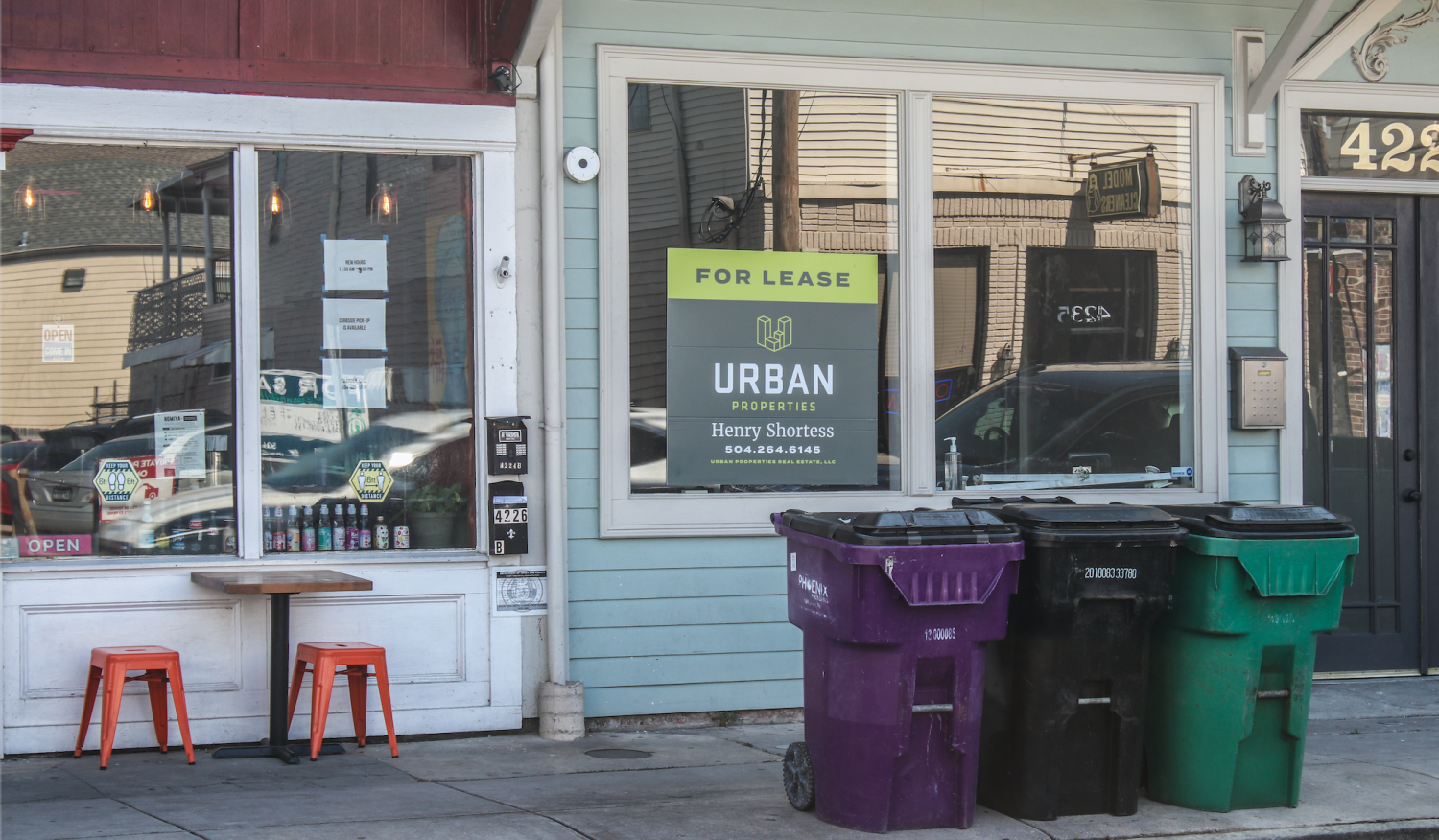
Retailers, restaurant owners and other merchants are navigating through unprecedented economic headwinds, including a precipitous drop in local tourism spending, safety concerns from their customers and high unemployment rates in the city. Those COVID-related worries are stacked on top of the pre-pandemic surge of online shopping, which has only accelerated as residents have hunkered in their homes clicking on their phones.
According to the National Retail Federation’s annual consumer holiday survey, 59 percent of shoppers surveyed “plan to shift more of their shopping online compared with last year.” How much they’ll spend, though, remains tougher to predict; the federation has delayed the release of its holiday forecast until it has “more solid data.”
“This will be a historic holiday season with no playbook for economists to follow,” said the federation’s senior director of media relations, Danielle Inman, via email.
While retailers and restaurateurs across the nation are much in the same boat, the financial fallout here has stroked an acutely New Orleans fear: if local shops on Magazine Street go out of business, will they be replaced by chain stores and national franchises once the economy recovers?
Advertisement
Though national brands have popped up along the street in recent years, Magazine proudly remains a bastion of locally owned businesses: art galleries, clothing boutiques, bars, antique stores, home décor ateliers, coffee shops, high-end restaurants, poboy shops and more. Part of the city’s cultural identity, many of these companies are housed in historic buildings dating from the 19th and early 20th centuries. What impact would a rash of vacancies have on these century-old storefronts?
“The local character of Magazine Street must be preserved,” said Guy Williams, president and chief executive officer of Gulf Coast Bank, which has a branch at 3200 Magazine St. “If it becomes a Dallas strip mall, then we’ve all lost.”
It’s hard to discern the exact number of Magazine Street businesses that have closed permanently during the pandemic, as some merchants have temporarily shut their doors, moving operations online with the hopes of returning to a bricks-and-mortar storefront in the future. Still, “the number of small businesses open in the metro area continues to remain well below the number that were open prior to the pandemic,” according to GNO Inc.’s COVID 19 Economic Dashboard.
The shops that still proudly display “we’re open!” signs aren’t relying just on foot traffic, though. “We have been working nonstop on our website, making it more user-friendly for the customers who want to shop from home,” said Margaret Jones, who co-owns Scriptura, a 25-year-old stationery emporium, with her husband Dave Isganitis and sister Sallie Jones. “Customers can now order personalized stationery on our website or through Instagram. We have also been developing new and affordable stationery products and limited-edition pens to encourage letter writing, since more than ever, this is a year to stay in touch with our loved ones.”
“This year has made all of us more technology driven, whether it’s Zoom meeting or shopping online,” said David Perlis, whose family’s clothing store, Perlis, has been on Magazine Street since 1939. “We do have an e-commerce business, and our customers can shop with us online and give gifts across the country.”
This year, local merchants have one advantage over their national competition: customers can avoid the delays and added costs of shipping by picking up their online purchases curbside. With forecasters predicting “shipageddon” this holiday season (coined by the podcast Retailgeek.com), a local pick-up option could be a super power for Magazine Street’s small businesses.
Salesforce.com “is projecting parcels shipped by traditional delivery providers — such as FedEx, UPS and DHL — will exceed capacity by 5 percent globally between the week before Cyber Week and Dec. 26. That means potentially 700 million gifts are at risk of not arriving at homes before Christmas,” CNBC.com reported on Oct 9.
“We are emphasizing local pick-up, making it really simple when you’re checking out online to select ‘pick up at the shop of your choice,’ ” said Dirty Coast’s Haney, who estimates that 75 percent of his business these days comes from online orders, while pre-pandemic, digital purchases accounted for 25 percent of his sales. “We have been investing in different tools, targeting new audiences. We need to make it really easy for people to shop where they feel comfortable.”
Advertisement
Predicting customer demand months in advance is like giving the Magic 8 Ball a shake this year, with uncertainty hanging over not only holiday shopping but also the 2021 Carnival season.
“Our business is more difficult in New Orleans on Magazine Street now than in our Baton Rouge or Mandeville stores,” said Perlis, whose family has dressed generations of New Orleanians for Mardi Gras balls, nonprofit galas and slews of festive parties. “All of our stores are hurting, but because of the event-driven nature of our business on Magazine, it’s harder here. For the retail apparel business, you have to have weddings, graduations, homecomings and parties. If there’s no reason to go out, there’s no reason to buy new. We sold 15 percent of the white linen suits we had for this year.”
While the drop in sales is worrisome, Perlis has no doubt that his family’s business will be able to successfully ride out 2020’s roller coaster. Like many longtime Magazine Street fixtures, the retailer owns its building, giving the business more flexibility than merchants who have to write big rent checks each month.
“During this whole pandemic, it has come down to: what did your balance sheet look like when we went into this,” said Peter Ricchiuti, an economist and business professor at Tulane University’s Freeman School of Business and host of “Out To Lunch,” a podcast and WWNO radio program about the New Orleans business community. Companies who do not have much debt and own their real estate will have a better chance at survival, he said.
Also the product mix is important. Magazine Street stores offer things you can’t find on Amazon — including personalized customer service and unique items filled with Crescent City pride.
“There are a ton of small businesses out there that sell big corporate stuff. We don’t,” said Starr Hagenbring, owner and designer with Art & Eyes optical boutique at 3708 Magazine St. “We also only carry about 5 percent Chinese (made) merchandise; and (that merchandise is from) U.S. companies that own their factories in China. …We are not interested in selling a look that 73 percent of the population wants to wear, so they can look like each other.”
Art & Eyes, which is celebrating its 10th anniversary this year, is housed in a double shotgun that dates from the 1920s, Hagenbring said. “COVID has brought some serious changes into our business. We work with the face — don’t touch your face — and we clean every frame that someone tries on in a UVC cabinet. We have UVC filters and lights in our HVAC system to clean the circulating air of molds, toxins and viruses. We have special areas where you can remove your mask and try on glasses. We book appointments, so there’s limited people in the shop, and you have our undivided attention. …We bought our building, so we don’t have a landlord, and we can do all these COVID preventive things without a discussion.”
Though the hardships are real all along Magazine Street, there remains an amazing amount of optimism among local merchants and restaurant owners. Many consider the pandemic a chance to refocus or try new approaches.
In early October, Tanya Becnel, Emily Morrison and Marti McEnery signed short-term leases for 3701 Magazine St., a light-filled building designed by Curtis and Davis Architects, according to McEnery Residential brokerage. The corner location has coveted off-street parking and an attractive courtyard.
The three entrepreneurs each own their own small businesses. Becnel sells hand-printed velvet and linen textiles from Italy, while Morrison sells silk and silk velvet textiles, pillows, caftans, clutches, totes, sneakers and more from Istanbul in her store, called Elysian by Emily Morrison. McEnery, an artist, will use her space at 3701 Magazine as an art studio.
“We believe locals will always shop on Magazine, and that tourists will continue to see Magazine as a world-class shopping destination,” said Morrison when asked why she chose to open a retail location now. “We chose this area in particular because we love being surrounded by so many high-end designers, creative artists and amazing retail stores in the heart of Magazine. It is a perfect spot to be located between the Garden District and Uptown for both locals and tourists.”
Advertisement
What pandemic? Some businesses are booming
While retailers and restauranteurs have suffered greatly during the pandemic, there are other businesses in New Orleans that are flourishing. Service providers, contractors and home repair technicians are seeing big demand.
“Our home improvement contractors are as busy as they can possibly be,” said Guy Williams, president and chief executive officer of Gulf Coast Bank. “Service businesses — pool services, home repair, airplane repair, boat repair — are just booming.”
“With homeowners spending more time at home, pros (design and remodeling professionals) received 58 percent more project leads in June of this year than they did in June 2019,” reported Erin Carlyle on Houzz.com, an online home remodeling platform.
Nationally, outdoor home improvements are among the most popular, with big demand in swimming pool construction, landscape design, deck and patio professionals. The stock for Poolcorp, an international distributor of swimming pool supplies, parts and outdoor living products, “is up over 54 percent this year,” CNBC.com reported in September. “The stock is on pace for its best year since 2003.”
Also on a tear this year: residential real estate. With so many people working and taking classes from home, there’s lots of desire for more space. Couple that with low interest rates, and the local real estate market is booming. “Every house that can be sold is sold,” Williams said.
New Orleans isn’t alone in seeing “Sold!” signs popping up on lawns. Across the country, “existing-home sales continued to climb in August, marking three consecutive months of positive sales gains,” the National Association of Realtors reported in September. Sales are up 10.5 percent from a year ago.
“Further gains in sales are likely for the remainder of the year, with mortgage rates hovering around 3 percent and with continued job recovery,” reported Lawrence Yun, NAR’s chief economist, in a press release. — Susan Langenhennig
Advertisement

This section of Magazine Street near Audubon Park has long had a village-like feel, with many businesses here catering mainly to local residents, rather than a tourist economy. The blocks between Jefferson and Nashville avenues are filled with small clothing boutiques, home decor and gift shops, coffee shops and restaurants. The commercial foot traffic here has historic roots, as the Ewing Market, a public food hall, drew shoppers to this area at the beginning of the 20th century, encouraging other retailers and service-oriented businesses to open nearby. While the majority of businesses today remain locally owned, there are a few notable exceptions, including Whole Foods grocery, Walgreen’s pharmacy, Pinkberry yogurt shop, Blue Mercury cosmetics and Kendra Scott jewelry. Many of these national brands opened here within the last 15 years. By contrast, this stretch of Magazine leading to Audubon Park also is home to some of the street’s most venerable businesses, including Perlis, which has served the sartorial needs of local residents from its block near the corner of Webster Street since 1939.
Notable structures:
900 Jefferson Avenue, corner of Magazine Street: This circa-1899 Queen Anne-style house was home to several pharmacy businesses over its history. Prior to the pandemic, it was a CC’s Coffee shop, but it’s been closed since the spring.
5500 Magazine St.: This circa-1907 building was originally the Ewing Market, one of several public food markets in New Orleans. It was renovated in the 1930s. Over the years since the public market closed, the building has housed many other businesses, including Mimi’s, an upscale women’s clothing boutique. Today, it is home to Joseph, a women’s specialty store with locations in Memphis and New Orleans.
5518 Magazine St.: Now a Walgreen’s pharmacy, this site was the original home of the Ed Brauner American Legion Post 307, and portions of the building date to 1947, according to Stirling Properties, the developer which purchased the property in 2011. The 13,000-square-foot building went through an extensive renovation before reopening as Walgreens. “To pay homage to war veterans and the building’s former use as a meeting spot for them, several American Legion images and symbols were incorporated into the new design,” Stirling said.
5600 Magazine St.: Constructed circa 1893, this building housed streetcars, and later buses, for many decades. The property was placed on the National Register of Historic Properties in 1996, and in 2001, the building was leased to Whole Foods Market. The grocery store opened in December 2002, and has served as an anchor for neighborhood businesses ever since.
6070 Magazine St.: Perlis, a beloved local clothier, was founded on this block in 1939 by Rogers Perlis. The store, which has expanded and evolved over the many decades, remains a family-owned business today, known for its formal and casual wear.
720 Henry Clay Ave., corner of Magazine Street: Home of St. Clare’s Monastery, this brick structure was built circa 1912 by the Poor Clare nuns. In the 1960s, the monastery became “a refuge for the Poor Clares of Havana, Cuba, who had to flee their home during the terrors of the Castro regime,” according to the religious order’s website. The Poor Clare nuns are a contemplative order and have only left the city once, after Hurricane Katrina in 2005. They returned to the monastery after “40 days of exile.”
Advertisement
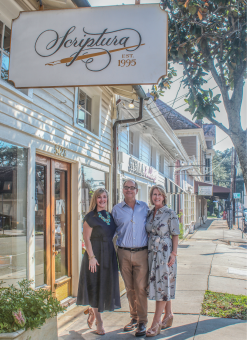 SCRIPTURA
SCRIPTURA
Margaret Jones (pictured on the right), co-owner of Scriptura stationery emporium with her husband, Dave Isganitis (middle) and her sister, Sallie Jones (left)
5423 Magazine St.
How long have you been a business owner on Magazine Street? – 25 years this month.
Do you own the building in which Scriptura is housed? – Yes, we bought it after Katrina.
What are your biggest challenges during the pandemic? – Creating a new financial underpinning for the business. The majority of our business is based on the custom design and printing of wedding, party and deb invitations. With almost all events on hold, we have had to re-imagine our product mix and find ways to get our message out to customers.
How has your staffing level changed during the pandemic? – We have reduced our staff to a core group of long-term employees.
Have you changed your business model because of COVID 19? – We have been working nonstop on our website, making it is more user-friendly for the customers who want to shop from home. More products are online, and customers can now order personalized stationery on our website or through Instagram. We have also been developing new and affordable stationery products and limited-edition pens to encourage letter writing, since more than ever, this is a year to stay in touch with our loved ones.
What types of assistance, if any, would be most helpful to your business? – Clear direction from the city about the re-opening phases. We need to know when we can expect events to resume, the amount of people that will be allowed to attend and a comprehensive plan for Carnival Season.
What would you like to tell the public about your business right now and how could the public help support you and Magazine Street in general? – Be mindful that shopping locally now ensures your favorite small businesses on Magazine Street will be here in the future.
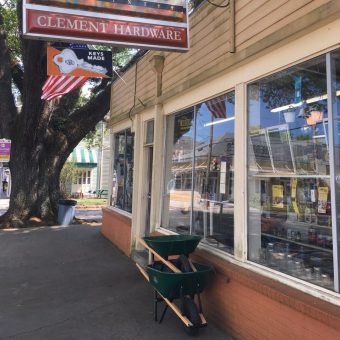 CLEMENT HARDWARE & VARIETY
CLEMENT HARDWARE & VARIETY
Darren Clement, owner
6000 Magazine St.
How long has Clement Hardware been in business? – My father bought this business in 1980, and my wife and I bought it from him in 2007. But there has been a hardware store here going back to the 1940s.
How is your business doing? – Our business has been steady. We never had to close. In the beginning, we were offering a lot of curbside service, and we still offer that, if people would feel more comfortable than coming in the store. In the beginning, a lot of people were staying busy with yard work, and we have supplies for that. But we didn’t have as many contractors coming in as we typically do.
How does Clement Hardware stay competitive in this tough economic climate? – We offer old-school, great customer service. It’s hard for us to compete with the big box stores, but what we offer is that personal service. People can call us, and we’ll have what they need waiting for them. We are here for our customers
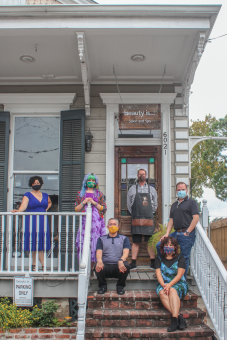 BEAUTY IS…SALON
BEAUTY IS…SALON
Randy Bossier and Robbie Hoard, salon owners and stylists; Tommy Centanni, stylist; Kayla Chiasson, color specialist; Jennifer Mantura, stylist and makeup artist; Paula Valencia, aesthetician.
6021 Magazine St. Housed in a late 19th-century shotgun double.
How long has the salon been at this location? – “We have been on this block since Hurricane Katrina, and in this building for six years,” Bossier said.
How is business during the pandemic? – “We were completely shut down from mid-March to May. We reopened May 16, and it was very slow all summer,” Bossier said.
“Before COVID, I was doing about four to five customers a day. Now, I’m doing about two customers a day,” Chiasson said.
“The people who haven’t come back are our older customers,” Mantura said. “They are still scared.”
“As a makeup artist, Halloween is usually huge for us, but I don’t have anyone on the books,” Mantura added. (This interview took place in early October.)
“I started to see my business pick up, but then the hurricane (threats) started,” Centanni said.
“It’s not just us. We don’t see the usual foot traffic up and down Magazine Street that we used to see. We don’t see the Tulane and Loyola students,” Bossier said.
The salon rents this space. Have you had any help from your landlord? – “Yes, our landlord was very nice. He gave us a break (no rent) for three months. He said, ‘Go take care of your people.’ We have been really good tenants, and we appreciate that help. We would have had to go into savings to pay it. But since the summer, we’ve paid full rent,” Bossier said.
How has your business adapted during the pandemic? – “We used to be by-appointment only, but now we welcome walk-ins,” Bossier said. “We also have been doing lots of social media, and we are putting more signs outside to encourage more walk-in customers.”
What are some of the things you’re doing to make your customers feel safe when they come in for a service? – “We were already spaced out well for social distancing,” Bossier said. (Located in a shotgun house, the stylists each have separate spaces in the various rooms.) “We can now offer services outside on our back porch, if customers would rather be outside. We all wear masks, and we clean everything. We are doing everything we can to keep our customers safe,” Bossier said.
Advertisement

Traveling Uptown on Magazine Street past Napoleon Avenue, the street is distinctly commercial, with restaurants, shops, salons, tattoo parlors and more. Past Lyons Street, a beautiful oak canopy shades the street, and many buildings on the thoroughfare turn residential. Though this particular stretch of Magazine Street is bustling, there are an odd number of long-vacant buildings, including a former Danny’s Chicken restaurant on the corner of Magazine and Valence streets that has been empty for years, and a magnificent Thomas Sully-designed church that has also been long abandoned.
Notable structures:
4521 Magazine St.: Originally a fire station established in the 1870s, this building today houses a gym and Thai restaurant.
Valence Street Baptist Church (pictured above): Built in 1885 and designed by Thomas Sully, this church building has been vacant for many years.
4905 Magazine St.: Lee Harvey Oswald lived in this double shotgun house before moving to Dallas and later being accused in the assassination of John F. Kennedy.
5116 Magazine St.: Founded by St. Katharine Drexel and the Sisters of the Blessed Sacrament in 1915 as Xavier University Preparatory School, this school was renamed and reincorporated in 2013 as St. Katharine Drexel Preparatory School. The original convent build remains on the site.
Poydras Home, 5354 Magazine St. (pictured above): Founded as an orphanage downtown in 1817 and supported by philanthropist Julien Poydras, it moved to this three-and-a-half-acre site in 1857. Its mission evolved, and today serves as a retirement community with independent living, assisted living, nursing care, Alzheimer’s and memory support, and a senior day program.
Advertisement
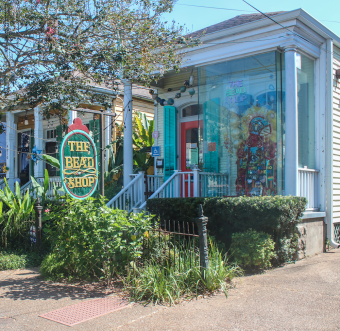 THE BEAD SHOP
THE BEAD SHOP
Georgia Wilson, owner
4612 Magazine St. Housed in a circa-1896 shotgun house
How long has the Bead Shop been in business? Have you always been located on Magazine Street? – We just celebrated 28 years in business this weekend. We have always been located on Magazine Street, and we love being a long-time Magazine Street business. The area is full of beautiful homes and businesses with a widely eclectic mix of offerings. We are blessed with a wonderful network of independently owned businesses here, but we love any business investing in the area, large and small.
What are your biggest challenges during the pandemic? – Our biggest challenges during the pandemic have been covering the costs to stay open, keeping my staff and myself safe and healthy while serving the public, and the daily challenges of non-compliant visitors who don’t want to follow the safety guidelines. It is very challenging when we create safe boundaries that make us comfortable serving the public in our small shop, and those boundaries are challenged and disrespected daily. The safety measures are to keep everyone healthy. They aren’t personal; we just want to stay safe, stay open and sell pretty beads.
How has your staffing level changed during the pandemic? – Thankfully we have maintained all of our full-time employees since March, and we remain committed to this. Our part-time staff is much smaller during the pandemic. We have less staff overall because we are open less. We are now open five days per week instead of seven. Our staff is incredible, and I couldn’t do this without them. They have been absolute rays of light during this incredibly hard time.
How has COVID 19 affected your business plan? – We restructured our business plan immediately, adding reactive and proactive solutions. Our wonderful manager developed a new store register system and shoppable website within a week of the Phase 1 announcement. We immediately added porch pick-up, curbside delivery, home delivery, private shopping appointments, live Facetime appointments and increased our online presence. We developed kids’ kits to capture the attention of new customers who were looking for something to do with their kids while stuck at home. We launched a YouTube channel, which is completely out of my comfort zone but was very necessary. We poured our energy into new product development and kit-based online sales, since we can’t offer in-store jewelry making right now. We developed new things, such as stone healing baskets, suited to your personal healing needs during this time of life. We created a “Herogram” so that people could order a custom bracelet for a “hero” in their life (nurses, doctors, teachers, front line employees). It took off, and we loved being a part of sending someone some love during such a dark time of life. We also set out to increase our store’s wholesale division by developing mask chains and wholesaling them to many local stores. We have had to learn to stay on our toes and adapt, but from a business perspective, this has been a huge learning experience and has awakened and developed some wonderful practices. There might be Amazon, but they can’t compete with personal attention. In a moment of pandemic fog, a customer forgot his wife’s birthday was coming up. He called me and give me his wife’s birthstone, her favorite color and a budget. So as I was creating a special piece for her, wrapping it carefully, hand writing a personal card, and dropping the gift on someone’s porch at night, the same day he ordered it, I was reminded why small businesses are special and vital to the community. Amazon doesn’t do that.
What types of assistance would be most helpful to your business? Is there anything supporters can do besides coming to your shop in person? – We would love to have you visit and support the shop! We have all of our current hours and shopping guidelines listed on our website. Please visit our website, which is only a fraction of what we have in store. We offer shipping and send packages out daily. We have beads, but if you’re not a beader, we have gift cards, gift items and ready-made jewelry. Let us help you make someone’s day. Please follow us on Facebook or Instagram, or both! @BeadShopNewOrleans
Do you think the Bead Shop’s COVID experience would have been different if you weren’t located on Magazine Street? – Yes and no. Every business in the city has been affected. One unique component of Magazine is that we have lost all tourism, so the normally busy street walking traffic is gone. We miss the bustling Magazine Street events, like Art for Art’s Sake. We have really seen the love and support from our local customers, and it has been so refreshing and appreciated. While we normally rely on tourists visiting Magazine Street, our locals have literally kept us alive since March. I do think they could park easier if we weren’t on Magazine Street, but we promise it’s worth the walk. Beauty and creativity await inside of our bead haven.
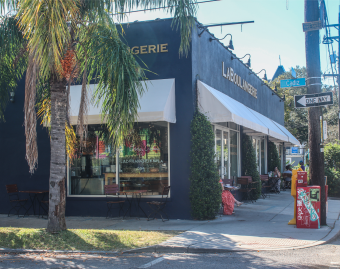 LA BOULANGERIE BAKERY AND CAFE
LA BOULANGERIE BAKERY AND CAFE
Maggie Scales, Executive Chef and Partner
4600 Magazine St.
La Boulangerie bakery was first opened in 2000 by Dominique and Bruno Rizzo. When did you and your partners, Chef Donald Link, Chef Stephen Stryjewski and the Link Restaurant Group, become involved in the business? – My partners and I took over La Boulangerie in November 2015. We opened to the public in December 2015.
What have been your biggest challenges during the pandemic? – There have been so many challenges. Between trying to keep our staff safe and ensuring that our customers venturing out feel safe and comfortable, that’s a full time job. On top of that, trying to figure out our business levels. Because everything is fresh baked, in the beginning of the pandemic, we were not sure what kind of business we were going to have. We quickly figured out that it was mostly online. And it was interesting to see what the big sellers were. But as the restrictions loosened in the city, more people came out to sit and enjoy themselves, and we tried to offer more options for people. We are still figuring it out as things change.
How has your staffing level changed during the pandemic? – Unfortunately, we had to lay off about 75 percent of our staff when the pandemic began. We are slowly hiring back as the business demands it. But we are still maintaining safe practices. In the kitchen, we have been able to staff enough to still work with safe distance.
How has COVID 19 affected your overall business model or plan? – We’ve had to adjust our thinking in how to accommodate customers safely. We’ve rearranged our set up and dining room probably 200 times since March. I’m also trying to stay tuned in to where customers’ heads are at. The sales of certain products have changed, and we’ve adjusted our menu accordingly, seen a huge uptick in sourdough bread sales. Similarly, in the beginning, we adjusted the business to only walk-up ordering. Once we figured that out, we adjusted for 25 percent capacity in the dining room. All the meanwhile, we were trying to figure out online ordering. We were lucky because we were already set up for online ordering, but it wasn’t as utilized as it could have been. But once the pandemic began, we prompted our customers to order online for their convenience and safety.
In addition to just visiting your bakery, how else can patrons support La Boulangerie? – When the pandemic began, and restaurants were temporarily closing, I felt nervous and helpless. I purchased gift cards to local restaurants in the city to help, and once they reopened, I either gave them as gifts or ordered take-out. So as the holidays are coming up, gift cards are always a great support. And because we are part of a restaurant group, they can be used at any of our other restaurants (Cochon, Peche, Herbsaint, Butcher and Gianna)
How does La Boulangerie on Magazine contribute to the Link Restaurant Group? How have its sales/patronage compared to the other restaurants around the city? – La Boulangerie provides all the bread, desserts and ice cream for our sister restaurants in the Central Business District. Since the pandemic began, we have been working really closely with the chefs in the other restaurants. We are all trying to figure out business levels together so it takes a massive amount of communication. I’m not sure about other restaurants outside of our own group, but La Boulangerie has been lucky to be in such a neighborhood spot. Pre-pandemic, we saw a good deal of tourism, but really our backbone is the neighborhood. From March through July, we definitely saw a dip in sales, but since that time it feels like our regular customers are back out and trying to support us as much as possible. It’s absolutely back to business as usual.
Advertisement

The buildings on this section of Magazine Street have a more residential appearance, though the vast majority of these homes have long been converted to commercial purposes, such as restaurants and shops. Most of these buildings were built in the last decades of the 19th century and the first of the 20th. This district includes florists, clothiers, restaurants of all scales, bridal boutiques, antique shops, design and furniture ateliers, art galleries, cafes, a hardware store, a veterinary clinic and much more. Though the majority of retailers are locally owned, many of whom have been in business for decades, in recent years a number of national brands have opened store fronts on this section of Magazine Street, including cosmetic and skin care retailer Keihl’s, clothiers J.McLaughlin, Marine Layer, UnTUCKit and Billy Reid, optical shop Warby Parker and others. This stretch also has many long-standing purveyors, however, such as Casamento’s restaurant, which is more than 100 years old.
Notable structures:
3437-39 Magazine St.: This Greek Revival center hall dates to 1869. It is now home to Dunn & Sonnier antiques and flowers.
3535 Magazine St.: Wooden doubles were once on this site. They were demolished around 1920 to construct the Menger-Fisher Motor Co. showrooms. The site is now home to Harry’s Ace Hardware, which was founded around 1970 by Harry Offner.
Jefferson Market, on the corner of Gen. Pershing Street: The market was established in the 1860s as one of the city’s many public markets. Today it serves as the gym of St. George’s Episcopal School.
4300 Magazine St.: Now home to the headquarters for Mignon Faget Ltd., this circa-1920 building was once home to Hibernia National Bank. Mignon Faget moved into the property in 1997.
4318 Magazine St.: Woolworth’s Five & Dime was originally located at 4308 Magazine St. (now home to Nirvana restaurant). Woolworth’s then moved next door to 4318 Magazine (pictured at bottom right), which is now home to Peaches records. Peaches still has the original Woolworth’s lunch counter inside.
4317 Magazine St.: This former Second District Police Station was originally built as a courthouse. It has been vacant since 2018.
Advertisement
 MODEL CLEANERS
MODEL CLEANERS
Jae (pictured above) and Frances Kim, owners
4235 Magazine St.
How long have you owned Model Cleaners? – “We bought the business 16 years ago,” Frances Kim said.
What are your biggest challenges during the pandemic? – “Only about one-third of our customers are coming back right now (because so many customers are working from home.) When they start working (at their offices) again, they will come back. When school opened, we saw a little improvement,” she said.
Has your staffing level changed? – “We had seven employees. Now we have three,” Frances Kim said. “With Jae and me, right now, that’s enough to do our work.”
Do you own your building? – “No, we own the business, not the building.”
Did you have any help from your landlord? – “Yes, our landlord, Donald Sachitana, lives upstairs. We bought the business from him. He gave us three months without rent (April, May and June), and we began paying again in July. He was very nice,” Frances Kim said.
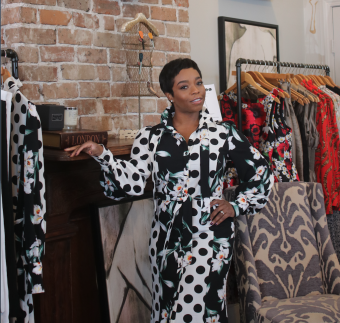 WEST LONDON BOUTIQUE
WEST LONDON BOUTIQUE
Mariah Walton Bencik, owner
3952 Magazine St.
How long has West London Boutique been in business? Have you always been located on Magazine Street? – West London Boutique has been in business for three years on Magazine Street. We have appeared in several pop-ups in the city of New Orleans, but have maintained our roots at 3952 Magazine St.
What are your biggest challenges during the pandemic? – Our biggest challenge during the pandemic has been our decline in walk-in traffic. We use the word “challenge,” but not to be merged with the word “setback.” Being in retail for over 20 years, I’ve seen my share of challenges, and this was an easy one to fix. I knew how to get our team to redirect our focus even more on enhanced relationships, as we should never depend on walk-in traffic. We should always be focusing on building current relationships, client service practices and what we call “going out and getting it.” This means when the business isn’t coming to us, we go out and get it by reaching out to our existing client base.
How has your staffing level changed during the pandemic? – Lucky for us, we’re only 500 square feet. In the shop, we run a two-person ship. I do the buying and merchandising, and Kenneth manages the business with me. We haven’t had to change staffing and could actually use another body.
How has COVID-19 affected your business plan? – Covid-19 has affected our business plan in the way that it forced us to go virtual with many events and practices. I’m old-school and enjoy being face-to-face with nearly all my interactions. We’ve had to pivot and dive deep into the world of technology to keep ourselves afloat and relevant. It’s definitely a work in progress and admittedly quite fun.
Are you committed to staying on Magazine Street? Why or why not? – Well, we never stay put. As of right now, we’re thrilled to have a two-month residency at the New Orleans Museum of Art, in addition to our anchoring shop. I think it’s safe to say we will always keep our grass roots at 3952 Magazine St. We also greatly enjoy our neighboring and surrounding businesses that inspire us daily.
What else would you like the community to know about your business? – It’s always important to recognize the time we’re given. When we were mandated to close at the onset of the pandemic, I looked at that as a time to complete my passion project, which was completing writing a book I had started. I’ve now sold nearly 100 books. It’s entitled Retail, She Wrote, and of course, is about the business of retail and retail practices. Use you time wisely, even if it’s given to you under dire circumstances. I live by a simple phrase: “Do what you love, do it in an adventurous place, make sure it helps people,” which is a quote from Diane Sawyer.
SOTRE HOME DECOR, GIFTS AND WELLNESS BOUTIQUE
Grace Kaynor, owner
3933 Magazine St.
How long have you been a business owner on Magazine Street? – Six years.
What are your biggest challenges during the pandemic? – Staying open, finding new opportunities, offering increased customer service and staying calm.
How has your staffing level changed during the pandemic? – Both staff members have decided to move out of New Orleans, and I had to rehire a new team. There have been challenges with hiring, but it offers an opportunity to look at things in a new way and even improve.
How has COVID-19 affected your business plan/model? – We have stepped up our level of customer service. We offer free delivery, and we are focusing on our online business. We also started doing Instagram videos.
How can residents support your business in this time? What other kind of assistance can the city or others provide? – Please shop local. Magazine Street is historically a local shopping mecca, and if the population doesn’t support us, the street will be given over to chains and ultimately lose its character. Furthermore, shopping will be far more generic, and you won’t find the special handmade luxury items that are not seen anywhere else.
How does your location on Magazine impact your company? – Could you succeed elsewhere and have you considered leaving Magazine? I do think I could succeed, but I love the buzz and energy of Magazine Street, and I love being located on one of the oldest shopping areas in the world.
Advertisement
The stretch of Magazine Street that traverses the Lower Garden District and Irish Channel includes some of the earliest architectural indications of the corridor’s rise to prominence as Uptown’s commercial spine. A public market at the corner with St. Mary Street served residents of nearby Coliseum Square, and on all sides extend blocks of brick row houses with shop windows below and living spaces above.
The stretch between Jackson and Washington avenues remains predominantly residential, but between Washington and Louisiana avenues, a plethora of dining and shopping options await in a mix of historic commercial spaces, altered houses and newer buildings.
Today, Il Mercato event venue occupies the renovated Spanish Colonial Revival-style public food market building designed by Sam Stone, Jr. in the early 1930s to replace an earlier open-sided wooden structure.
The 1885 Sanborn Fire Insurance Map shows two coffee roasters operating at that time between Josephine and St. Andrew streets. Nearby were restaurants, furniture stores and ice vendors. Today, coffee shops, eateries and home goods stores are Magazine Street favorites, and the serviceable shopfronts have proven their adaptability.
Residents and tourists both can enjoy a shave at Aidan Gill, a tony men’s grooming emporium, before sauntering over to just-dive-bar-enough Juan’s Flying Burrito for Tex-Mex. They can get their pet primped at the Southern Animal Foundation’s Grooming by Lesa and have their own manicure done next door at Lilly’s Nails and Spa.
Those looking for chic clothing or a cold beverage won’t have to stroll for long. Most of the area’s retail establishments are housed in mixed-use buildings. Their idiosyncrasies are often the result of alterations made by successive generations.
Advertisement
Greek Revival dentil cornices are the norm, but a few boast newer Italianate parapets. Most have tall windows opening onto galleries of decorative cast iron, but some use more austere wrought iron. The galleries shade a marvelous variety of vitrines: shop windows, often projecting into the sidewalk and embellished with trim and pilasters of their own. In some hang ominous “For Rent” signs, reminders of the toll the COVID-19 pandemic has taken on small businesses.
This year isn’t the first time businesses have struggled to make a go of it on Magazine Street, however. Nearing downtown, after several tree-lined residential blocks, gaps in the charming facades reveal barren parking lots and metal sheds, reminders of a time when this part of the street was not regarded as a desirable place to live or shop.
In the past decade, infill development began to sprout on lots cleared of historic buildings by 20th-century demolitions. Tenants in Framework, a recently completed mixed-use development, include Satsuma restaurant and MVMT by Romney fitness studio. When the pandemic hit, Satsuma expanded its use of outdoor seating in a tented courtyard alongside Claret wine bar and restaurant.
Owner Felicity Property Co. also has plans to build a three-story office and retail building nearby on the site of a parking lot and non-historic building. “We plan on breaking ground in probably January or February,” said Jack Egle, a commercial broker for Felicity. “COVID certainly slowed things down a little bit.” Nevertheless, he is optimistic that the open areas, outdoor courtyards, large staircases and touchless systems included in the Eskew, Dumez, Ripple-designed “Melp and Mag” development will appeal to businesses in need of COVID-concious office space, including those fleeing cramped elevators and downtown rents.
Egle posits that the future of retail is a “bricks and clicks” hybrid that offers consumers both online and in-person options. He remains optimistic, saying, “In an economy like New Orleans where people take a lot of pride in supporting local businesses, people yearn to support local shops. The long-term impact is probably less in a community like New Orleans.”
Notable structures:
1175 Magazine St.: This three-story townhouse was the lone masonry residence on the block in the 1880s; most of the wooden residences then surrounding it were replaced by industrial sheds in the 20th century but it remains.
1330 and 1332 Magazine St.: The ground floors of these twin, brick, Greek Revival buildings with cast-iron balconies housed a corner store and bar in the 1970s, when they were approximately 120 years old.
1400 Camp St.: Don’t miss the large clock in the parapet on the rear of the International School of Louisiana overlooking Magazine Street.
1426 and 1432 Magazine St.: These stuccoed masonry homes likely were built soon after the Civil War and retain their lacey cast-iron galleries and original cast-iron cornices.
1507 Magazine St.: Builder Thomas Milligan erected the red brick St Vincent’s Infant Asylum beginning in 1864; today it’s being restored for hospitality use and best admired from the tables at nearby Mojo Coffee.
1800 Block Magazine St.: Greek Revival stores (pictured above) built in the 1850s line both sides of the block; the galleries there today were all re-introduced after 1970.
2000 Block Magazine St. (river side): Likely constructed in the 1870s, many of these adjoining Italianate buildings with curving parapets have surviving cast-iron lintels and galleries.
2123 Magazine St.: Built in 1877 for the Lafayette Fire Insurance Co., the Italianate design with an arched window and deep, bracketed cornice has been joined to its neighbor at 2127 Magazine to accommodate Louisiana Dental Center and Goorin Bros. hatmakers.
2319 Magazine St.: Designed by James Gallier, Jr. for his colleague John Turin, this masonry home was completed in 1854 and listed on the National Register of Historic Places in 1973.
3000 Magazine St.: True to its name, the Orphanage Apartment building, also home to Mayan Import Co., was formerly the Protestant Orphans Home.
3200 Magazine St.: The former Canal Commercial Trust and Saving Bank, with a steel frame and pronounced pediment, now houses Gulf Coast Bank. When it was built, the Ninth Street Market was located across Harmony Street.
Advertisement
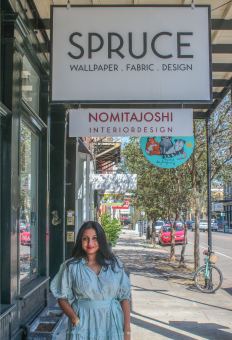 SPRUCE WALLPAPER. FABRIC. DESIGN
SPRUCE WALLPAPER. FABRIC. DESIGN
Nomita Joshi-Gupta, owner
2043 Magazine St.
How long have you been a business owner on Magazine Street? – I’ve been in business since 2008, and on Magazine since 2009. When I got to Magazine Street, it was bustling; you could not even find a spot to rent. Fortunately the spot (we have) opened up on lower Magazine.
What are your biggest challenges during the pandemic? – When the pandemic hit, it was a shock to everyone (and) very confusing. Many businesses couldn’t handle it. We created a “book online” tab on our website (so customers could make appointments) and spent a lot of time on administration. Weirdly it worked. Suddenly after the pandemic hit, there were people wanting paint consultations. They began to think: I’m sitting at home, so I can actually manage this project. I began to feel there was a glimmer of hope. Since then, we have been ridiculously busy.
How has your staffing level changed during the pandemic? – From the beginning, I’ve said I don’t want to let go of my one amazing assistant. My way has always been to keep operating costs as low as possible and use a lot of people on a contract basis.
How has COVID 19 affected your business plan? – I’m actively looking at trends in the world. In 2015, when all these big-box retailers started to move in and Amazon and Etsy started to be a thing, I made a decision. I sold all my retail and started 2016 with only wallpaper and fabric. It worked. We added paint this year. It really helped me grow a very niche business as a designer and service-oriented.
What types of assistance would be most helpful to your business? – My landlord has been so helpful. Early on they said, ‘We’re going to give you three months rent.’ I will forever be grateful to them for that. … I do feel there needs to be some sort of messaging to make people buy local. Maybe the state or city (could) offer technology to help small businesses. If we have to compete with online shopping, then let’s help you do it.
How does your location on Magazine contribute to your company? – Magazine Street is like being on any major shopping street in the world. If I’m applying for a design or wallpaper account in London, for example, if I say we’re located on historic Magazine Street, the credibility we get is unquestionable.
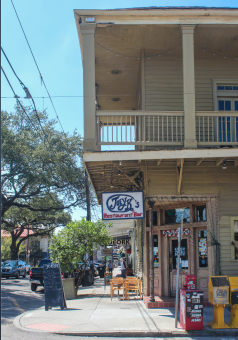 JOEY K’S RESTAURANT
JOEY K’S RESTAURANT
Sam Farnet, co-owner with his wife, Cindy. Their daughter Manny now helps run the business.
3001 Magazine St.
How long have you been on Magazine Street? – 30 years.
What are your biggest challenges during the pandemic? – The staff has been very concerned about contact with lots of people. They’ve been great the whole time, but it’s been a challenge. The amount of customers coming in, the seating and the social distancing have been a challenge.
Has your staffing level changed during the pandemic? – We have a lot of long-term employees, and they’ve had various situations between taking care of parents and children. We’ve had just enough staff to handle the amount of volume we’ve had. The ranks are pretty thin. We’d like to hire more.
Has COVID 19 affected your business plan? – We never closed the doors. We pivoted straight to takeout. The front-of-house staff stayed because we were able to keep the doors open throughout. We’re very lucky that we bought the building a long time ago, so we don’t have financial pressure of paying rent every month.
What types of assistance would be most helpful to your business? – My wife and I have both been on the board of the Magazine Merchants Association, so we’ve seen a lot of changes and know a lot of the merchant members. The shop owners are struggling. It’s a mixed bag, but I think the landlords understand that if they have a good tenant they need to help them.
How does your location on Magazine contribute to your company? – We’re very fortunate to be in a neighborhood setting, because the bulk of our customers are neighbors and shop owners. It’s like bread and butter: the neighbors are the bread, and the tourists are the butter.
Advertisement
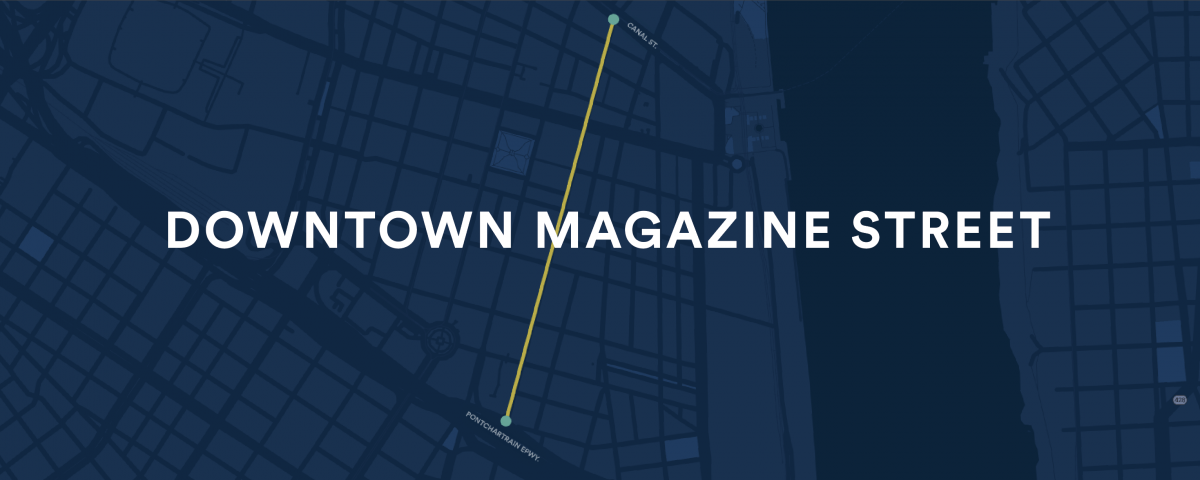
The downtown portion of Magazine Street, between Canal Street and the Pontchartrain Expressway, has a more urban feel than the Uptown stretch of the corridor. In addition to 19th-century warehouses and townhouses, early 20th-century commercial buildings and several steel-and-glass skyscrapers soar above the street. While the skyline of this segment of Magazine appears more outwardly modern in many ways, this area is actually one of the oldest parts of the street.
The street was laid out in a plan by Spanish surveyors in 1788, following the great fire that destroyed much of the French Quarter. After the disaster, the city expanded upriver and subdivided the land of the former Gravier plantation into a new faubourg, or suburb, eventually named Faubourg Ste. Marie. Although the area was first developed in the late 18th century, the oldest extant buildings in the neighborhood today date to the 1830s, according the National Register of Historic Places.
Notable structures:
101 Magazine St.: Three formerly vacant 19th-century Italianate buildings were transformed into the Sazerac House, the headquarters of the Sazerac Company, complete with a functioning distillery and a state-of-the-art-cocktail museum. (Read more about the renovation of this historic building in the October 2019 issue of Preservation in Print.)
200 Magazine St.: Home of the Ruby Slipper cafe today, this ornate, circa-1881 Italianate building has arched windows, quoins, a bracketed cornice and an elegantly curved corner. The canopy wrapping around the building’s first floor provides shade to outdoor seating at Ruby Slipper.
300-06 Magazine St.: These three adjacent brick stores were designed by famed New Orleans architect Henry Howard and built in 1851. The upper floors now have residential uses, but the first-floor retail spaces currently appear to be vacant and for lease.
301 Magazine St.: Now home to Nesbit’s Magazine Street Market, this stately Greek Revival-style granite building, complete with fluted Doric columns and a frieze with triglyphs, was designed by noteworthy architect James Dakin and built in 1843 as the offices of the New Orleans Canal and Banking Company.
330 Magazine St.: The St. James Hotel, with its delicate cast-iron balconies, is a surviving portion of an 1833 structure, the Banks Arcade, which once took up the entire block and once had a glass pedestrian arcade that extended from Natchez to Gravier streets.
725 Magazine St.: Now home to Bittersweet Confections, guests at this bakery and café enjoy coffee and baked goods in a circa-1939 building that originally housed a coffee company, according to the building’s National Register listing for the Upper Central Business District Historic District.
801 Magazine St.: Now home to Auction House Market, this late-19th-century brick warehouse building at the corner of Magazine and Julia streets was redeveloped into a food hall in 2018. Its tenants include a cocktail bar and several local restaurants.
800 Magazine St.: Built in the mid-19th century and given an Italianate makeover in 1884 by the F. Johnson & Sons livery and undertaking business, this historic building had lost most of its historic character in the 20th century but was meticulously restored — and its Italianate facade and galleries rebuilt — during a renovation. It is now home to Pêche restaurant.
Advertisement
HIGGINS HOTEL & CONFERENCE CENTER
Marc Becker, Director of Sales & Marketing
1000 Magazine St.
How long has the hotel been open? – We opened in December of last year.
Tell us a little bit about the hotel and the building. – We are a fully owned subsidiary of The National WWII Museum. Unlike many other hotels whose mission is to generate more profits for the owners, our mission is to support the educational goals and endowment of the museum. The hotel is a new build, but it has a 1940-era Art Deco design, which was the period of the war.
How has COVID-19 affected business? How have you had to adjust? – We are a Hilton Curio, and Hilton provided us several protocols, including the extra deep cleanings, masks, signage and floor stickers, which everybody is now very familiar with. We adopted all of that, and then we had to start looking at what kind of business might still be out there, because not only had leisure guests stopped, but the business travelers had stopped. We made the choice to remain a hotel, which meant still providing food and beverage, room service and housekeeping service, but we consciously wanted to give the experience as best we could that was the real hotel experience and not the truncated version that a lot of hotels were forced to do. That has proved relatively successful, and some of our transient business returned. First, it was for medical procedures, family funerals and things that make you travel even when you don’t want to travel, and then it was people who wanted to get out of the house just to get away.
How has your staffing level changed during the pandemic? – Before COVID, we had 178 employees, and most were full time. Right now we are at 28.
How can the public help support the business? – Come have a drink at Rosie’s on the Rooftop. If you’ve been a guest at the hotel, tell everybody on Tripadvisor that you’ve had a good stay. One of the reasons we’ve continued to do as well as we have is because we are No. 1 on Tripadvisor.
 BITTERSWEET CONFECTIONS CAFE AND BAKERY
BITTERSWEET CONFECTIONS CAFE AND BAKERY
Cheryl Scripter, owner
725 Magazine St.
How long have you been in this location? – I started out in this particular space eight years ago.
How has COVID-19 affected business? – When the pandemic hit, it just turned a light switch off for us. We used to get people walking down Magazine on their way to the museum who would stop and have breakfast or lunch with us, but we just don’t have visitors anymore. I feel very lucky that the regulars that we did have that worked downtown continue to come in and support us. Literally, these locals have kept us going.
Have your relationships with your customers changed amid the pandemic? – We’ve always been friends with most of our customers, but since this has happened it’s given us more opportunities to talk to them because we’re not as busy. Some of our regulars even call us to say “Look, I just want you to know I’m going out of town for a week, nothing’s wrong, and I’ll be back next week, but I just wanted to let you know!” And it’s great. We want to make sure everyone is healthy, too.
How has your staffing level changed during the pandemic? – I had 30 employees between two locations, and now I have 10. I shut my Mid-City location down except for on weekends.
One of the things your shop is known for is its delicious cakes. With fewer parties and gatherings during the pandemic, have you had to shift focus elsewhere? – I feel like the cakes are the reason we’ve kept our lights on. The size of the gatherings have changed, so the size of the cakes are smaller, but we still have loyal customers that come back and want cakes and cupcakes. We’ve been blessed by people still coming in, and even though they’re not having as big of a party, they’re still trying to have some level of a normal celebratory event by sharing cake with their family and friends.
What are your biggest challenges during the pandemic? – Because it’s been so painfully slow, it’s been hard to manage the menu and the food. Instead of doing weekly shopping like we’ve been used to, we’re having to do smaller, more frequent shopping, because we still want to hold our reputation for serving fresh and delicious food, but we’re having to deal with spending more time having to go and pick it up.
How can the public help support your business and Magazine Street in general? – We have expanded our catering menu for Thanksgiving this year. We don’t want to do your turkey, but we want to make you some delicious Thanksgiving sides to go along with, of course, our desserts. That will be something hopefully that will help us get through to the end of the year. When you shop at a local business instead of shopping at a chain, you’re helping out a fellow New Orleanian. Having locals support you just means you’re supporting your neighbors.
Susan Langenhennig is PRC’s Director of Communications and the editor of Preservation in Print.
Danielle Del Sol is the Executive Director of the Preservation Resource Center.
Nathan Lott is PRC’s Advocacy Coordinator & Public Policy Research Director.
Davis Allen is PRC’s Communications Associate and a staff writer for Preservation in Print.
Advertisements

